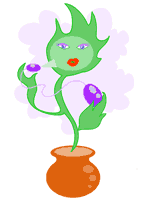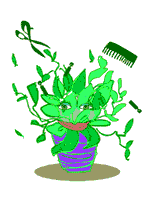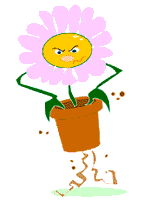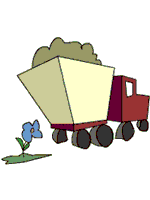|
 
|

Great
garden tips
Over the months we've
collected a wealth of hints and tips for the garden. Here's the
story so far…
- Comfrey added to your
compost bin will aid decomposition. The leaves are rich in nitrogen,
which assists in the breakdown of dry material.
 Lavender
produces its most fragrant flowers in poor soil. In rich soil
the fragrant essential oils are lacking. Lavender
produces its most fragrant flowers in poor soil. In rich soil
the fragrant essential oils are lacking.
- Plant hyssop with
cabbage to deter white cabbage butterflies.
- Weak or broken stems
of plants can be protected by placing a drinking straw (slit lengthways)
over the break to support it.
- A teaspoon of milk
powder added to the soil when planting your tomato plants will
ensure an even ripening of fruit. When the first truss of flowers
open, add a heaped teaspoon of sulphate of potash to ensure good
red colouring and fruit set.
- Leftover water from
boiled potatoes makes an excellent organic weedkiller for paths
and patios.
- To repel pests from
your veggie patch, crush the leaves of lemon balm and sprinkle
amongst your plants.
- Annual herbs are best
sown directly into the ground, as most do not like transplanting.
Root disturbance can cause the plants to go to seed. This is especially
true for coriander.
- Banana skins at the
foot of plants will lure aphids away and add a dose of potassium
too.
- Aphids can also be
lured away from your crops by placing a yellow bowl half filled
with water amongst your veggies. Aphids, being attracted to yellow,
will land on the water and drown. Alternatively, cut some yellow
card, smear with petroleum jelly, attach to a stick and plant
amongst your veggies.
- As new shoots grow
on a climbing rose, tie down horizontally. Side shoots will form
right along the cane, and each of these will produce flowers.
If left upright, flowers will form only at the top.
 Climbing
roses do not need pruning for three years after planting. Climbing
roses do not need pruning for three years after planting.
- Create a natural rose
tonic by fermenting banana skins in a sealed jar of warm water
for a couple of weeks.
- The nutrients from
eggshells are ideal for the garden. Place broken shells in a watering
can, fill with water and leave overnight. Water the garden in
the morning. Alternatively, use the water that you boil your eggs
in as a tonic for your indoor plants.
- To gloss the leaves
of your houseplants, use a mixture of half water and half milk.
- Oat bran scattered
amongst plants is said to kill slugs and snails.
- To avoid getting weedkiller
on cherished plants, place some piping over the unwanted weed
and spray inside the pipe.
- Pine needles can be
used as a mulch around acid-loving plants such as rhododendrons
and camellias.
- Studies show indoor
plants are best watered when it's raining! Plants can supposedly
sense approaching rain and will increase their water uptake.
- Add food colouring
to your weedkiller solution to easily identify which weeds you've
sprayed.
-
 To
prevent vigorous groundcovers (such as ajuga) from choking other
plants' root systems, 'plant' pots amongst the groundcover and
fill with desired plant. To
prevent vigorous groundcovers (such as ajuga) from choking other
plants' root systems, 'plant' pots amongst the groundcover and
fill with desired plant.
- Young runner beans
respond well to a heavy straw mulch.
- For some reason seedlings
that spring up on their own are far healthier and rarely get attacked
by snails.
- Ants are said to never
cross a chalk line. Try it, and see for yourself.
- Humus and compost
can retain up to 80-90% water. A clay soil, which is said to be
the most water retentive, holds only 15-20%.
- For plants in large
containers that are impossible to repot, remove the top 5 to 7cm
of soil and replace with fresh potting mix every two years.
- Sterilise pots that
have contained a diseased plant before reusing. Mix 1 part bleach
with 9 parts water, scrub pot, rinse and leave for 2 days.
- You can test the viability
of old seeds by pouring them into a glass of water. Those that
sink have a better chance of growing than those that float.
- To discourage birds
from eating your strawberries, scatter red marbles amongst them.
Birds will get fed up with pecking glass and leave the fruit alone.
- Slugs and snails love
dead leaves and debris. Regularly clear away fallen leaves from
your garden beds and paths.
- Coffee grounds can
be used as a fertiliser and are also a wonderful pest control
when sprinkled at the base of plants.
 Sprigs
of rosemary scattered around the garden are said to repel slugs. Sprigs
of rosemary scattered around the garden are said to repel slugs.
- Tomatoes will lose
their flavour and texture if stored in the fridge. They should
be kept at room temperature, just as bananas are stored.
- To attract birds to
your outdoor birdbath, drop in a few coloured marbles.
- Vinegar poured onto
the affected area will kill grass on walks and driveways.
- Applying a teaspoonful
of salt can individually kill a weed such as dandelion in your
lawn.
- Keep cats out of your
garden bed by putting citrus rinds on the soil. Alternatively,
try sprinkling with onion and garlic peelings. Mothballs are said
to work on both cats and dogs.
- Soak used tea bags
in water, making a mild mixture to water your plants with once
a month to maintain proper soil acidity.
- Most plants with grey
or white leaves are drought-tolerant.
- Also drought-tolerant
are many sweet-smelling plants. The volatile oil in aromatic leaves
helps retain moisture by producing a protective haze around the
plants.
- Because they can make
use of nitrogen from the atmosphere, bean plants will actually
enrich the soil in your garden.
- Plastic soft drink
bottles with their bottoms cut off make great cloches for seedlings.
- Birch trees next to
compost bins are said to help in the breakdown of plant material.
The roots excrete a substance that helps in the fermentation process
of organic matter.
- Buy lemon trees that
are 1-2 years old not 3-4 years old. They are better at transplanting.
- Old Venetian blinds
make ideal plant markers in the garden when cut into small strips.
- Spray pesticides on
still days. If you can smell it, you're inhaling it.
- Hibiscus should be
planted in pots that are as wide as they are deep. As their feeder
roots spread out almost horizontally, tall narrow pots are unsuitable.

DID YOU KNOW...
- The earthworm has
no lungs; it breathes through its skin.
- Slugs can stretch
to 20 times their normal length, enabling them to squeeze through
the tiniest of gaps.
- Not only can a slug
follow a slime trail left from the night before, other slugs can
too, leading a host of them to your luscious plants!
- Slugs' eggs - white,
oval and laid in clusters of 12 - can remain in soil for years
before hatching. They need moisture to hatch.
- It is estimated that
millions of trees in the world are accidentally planted by squirrels
who bury nuts and then forget where they hid them.
- Bees have 5 eyes and
2 sets of wings to help them forage for nectar and pollen. They
must collect nectar from two million flowers to make a 450 gram
comb of honey.
- The orchid releases
a chemical that makes bees drunk. When the bee becomes disoriented,
it dumps its load of pollen into the flower, thus pollinating
the flower.
- Alliumphobia is the
fear of garlic, anthropophobia the fear of flowers and euphobia
(not to be confused with euphorbia) the fear of hearing good news.
- Plant life in oceans
makes up about 85% of the greenery on Earth.
- The world's largest
orchid can grow to 20m long.
- It takes 27 minutes
of gardening to burn 100 calories.
- Lettuce is a member
of the sunflower family.
- Strawberries are a
member of the rose family. They are the only fruit with seeds
on the outside rather than the inside. However, they normally
do not reproduce by seed. On average, there are 200 seeds in a
strawberry.
- Sunflower stems were
used to fill lifejackets before the advent of modern materials.
- There are approximately
13,000 identifiable varieties of roses throughout the world.
- The snail mates only
once in its entire life and can take as long as 12 hours to consummate
the act.
- Some olive trees in
the eastern Mediterranean are estimated to be over 2,000 years
old.
- The oak tree can take
as long as 30 years to produce its first crop of acorns.
- Oak trees are struck
by lightning more often than any other tree. This may be why the
ancient Greeks considered oak trees sacred to Zeus, god of thunder
and lightning.
- Carnations were used
to spice wine and ale during Elizabethan times.
- In the 10th century
carrots were white or purple - not orange.
- There are more than
5000 varieties of potatoes in the world.
- Potatoes were banned
in Burgundy in 1910 because it was believed frequent use caused
leprosy.
- Cabbage is 91 percent
water.
- The bark of the redwood
tree is fireproof. Fires in redwood forests take place inside
the trees.
- Roman historian Pliny
listed 61 medicinal uses for garlic, including warding off vampires,
restoring hair loss, and preventing warts.
- A notch in a tree
will remain the same distance from the ground as the tree grows.
- If you were to rub
garlic on the heel of your foot, it would be absorbed by the pores
and eventually show up on your breath.
- Twenty thousand plants
are listed by the World Health Organization as being used for
therapeutic purposes.
- Bees and houseflies
flap their wings 200 times a second, mosquitoes 600 times, and
a tiny gnat 1,000 times.
- The most drought-resistant
tree is the baobab tree. It stores 136,000 gallons of water in
its trunk for later use.
- An orange tree may
bear oranges for more than 100 years. The famous "Constable Tree,"
an orange tree brought to France in 1421, lived and bore fruit
for 473 years.
Reproduced
with permission from NZOOM Home and Garden content,
from the previous
website of 
The views expressed here are not necessarily those of the RNZIH
 |
|
HOME
AND GARDEN |
|
|
More
Garden Articles
|
Home | Journal
| Newsletter | Conferences
Awards | Join
RNZIH | RNZIH Directory | Links
© 2000–2025 Royal
New Zealand Institute of Horticulture
Last updated: March 1, 2021
|
|
|


 Lavender
produces its most fragrant flowers in poor soil. In rich soil
the fragrant essential oils are lacking.
Lavender
produces its most fragrant flowers in poor soil. In rich soil
the fragrant essential oils are lacking.  Climbing
roses do not need pruning for three years after planting.
Climbing
roses do not need pruning for three years after planting.  To
prevent vigorous groundcovers (such as ajuga) from choking other
plants' root systems, 'plant' pots amongst the groundcover and
fill with desired plant.
To
prevent vigorous groundcovers (such as ajuga) from choking other
plants' root systems, 'plant' pots amongst the groundcover and
fill with desired plant. Sprigs
of rosemary scattered around the garden are said to repel slugs.
Sprigs
of rosemary scattered around the garden are said to repel slugs.
